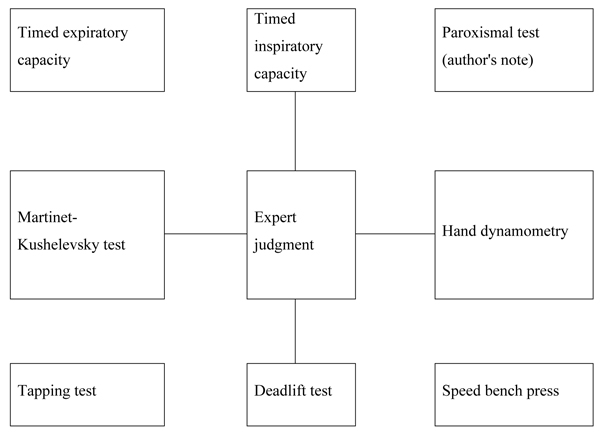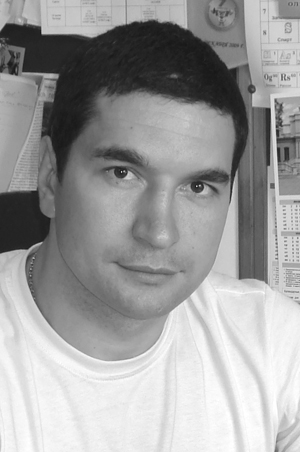Paroxysmal Test in Fitness Shape Evaluation for Powerlifters
Фотографии:
ˑ:
D.D. Dal'sky, senior lecturer
P.F. Lesgaft's National State University of Physical Education, Sport and Health, St.Petersburg
Key words: test, powerlifting, integral indicator.
Introduction. Sometimes it takes a lot of time to get and process research results, whereas a trainer should make a decision to change the training process almost immediately [1]. Now thanks to the use of medical-educational tests in the educational-training process outstanding results can be achieved with the operational assessment of functional status and without doing harm to athlete’s health. Currently, there is no doubt that, along with the indisputable positive influence of sports and physical culture occupations in all of its forms, the negative impact of these classes is also possible in case of their irrational use [4]. Therefore, medical-educational tests are needed with the operational information for a trainer and an athlete for timely identification of unsustainable load for an athlete’s body in a training session.
Medical-educational tests such as Serkin, Stange tests (analysis of external respiration), orthostatic test, Rufie index (analysis of the state of cardiovascular system) analyze autonomic nervous system, while the paroxysmal (author's note) test (from Greek praxis – adequately coordinated, purposive action) can be used to control central and somatic nervous system. Paroxysmal test is a derivative of the tapping test, but more convenient and informative. Using this test one can not only get accurate and up-to-date information on the current functional status of an athlete, but make early amendments in the training process to prevent industrial diseases [2]. The suggested method provides on-line information for a trainer on the dynamics of functional status and physical working capacity of powerlifters, ensuring timely selection of the optimal individual load during training sessions and competitions and taking prompt tactical decisions during competitions [3].
This test is used to estimate compensation abilities of central and somatic nervous system before and after training, recovery rate depending on the load extent and the distribution of the training and rest regimes and reveal if extra recreational procedures are required, and correct the training process.
The purpose of the study was to analyze accuracy, tempo, motor coordination, attention concentration and to reveal ataxia and hyperkinesia.
Materials and methods. Proceeding from the studies, rest intervals are insufficient, there are too many repetitions or on the contrary – not all reserves of athlete’s body were involved.
The research group was made of 62 male powerlifters and students of the general course of the trainer’s faculty of Lesgaft NSUPhC aged 18-23 years. The research was based on the department of theory and methodology of athleticism of Lesgaft NSUPhC, St.Petersburg. The classes lasted 1,5 hours three times a week.
General characteristic of daily routine:
1) Sessions in classrooms 6-7 hours
2) Specialized training 2-2,5 hours
3) Rest 4 hours
4) Sleep 8-10 hours
All subjects had no complaints about overall health. The examination was conducted before each training session in the following parameters: external examination (condition and color of skin, nasal breathing, visual disturbances of the locomotor system), measurement of heart rate (HR), systolic blood pressure (BP), Ashner test, orthostatic, clinostatic, paroxismal (author's note) test.
Characteristics of the test. During the paroxismal test the subjects drew circles at the same distance from each other, from smaller to bigger size (with increasing diameter). Time of the test – 15 seconds.
Before a training session the whole group of athletes managed to draw 12-15 circles.
After a 1,5 hour training session 60% of the subjects - 11-14 circles, 30% - over 15% circles and 10% - less than 10 circles. After training sessions of more than 2 hours the results were as follows: 50% - 11-14 circles, 20% - 15 circles, 30% - less than 10 circles, indicating a decrease in attention concentration and physical working capacity, reduced peripheral sensomotor function. In addition, ataxia (pointing, tremor) was detected in two athletes.
Athlete’s physiological condition should be a starting point for scheduling individual training sessions by a teacher and a sports doctor. Since Hippocrates the main rule “Do no harm" should be also the first rule for a trainer. Distracted attention, overstrain can lead not only to poor sports performance, but also increase the risk of sports injuries. Sports exercises mean imposing increased requirements to a body, so assessment of reaction and recovery of the body are important.
Physical fitness was assessed using eight tests, not frequently used, but rather perspective to obtain the purpose of the research. These tests have been identified by the previously held survey of elite trainers, analysis of the literature and personal practical experience.
Comparative analysis. The criterion of informativeness and predictive value of the test or indicator was its reliable relation with an expert assessment of fitness level of subjects and available multiple links with any other indicators.
The figure shows the paroxismal test in the system of medical-educational tests characterizing athlete’s current functional status.

Scheme. Paroxismal test system in the system of medical-educational tests
Estimating a set of indicators for each novice athlete and compared with the results of other athletes, a trainer can see each athlete’s predisposition to exercises. Based on the experimental study, we can conclude that the presence of an information component, namely the use of rapid tests in the overall structure of professional and pedagogical position, is very important as they provide the "usage" of information for all its constituent components: medical-pedagogical, managerial, sports, teaching and designing, innovation ones, as confirmed by the results of the research in the experimental group
To assess the functional fitness of powerlifters for physical load during training sessions and competitions 5 medical-educational tests were applied that directly describe the state of the cardiovascular and nervous systems, as those systems of the human body most quickly react to emotional and physical loads.
1. Orthostatic test (characterizes the excitability of the sympathetic nervous system). The methodology consists in analyzing changes in heart rate and blood pressure in response to athlete's changing from horizontal to vertical position. Heart rate (HR) per 15 seconds is calculated. Pulse difference is determined in horizontal and vertical positions. The standard of the test - heart rate increased by 8-12 bpm. For convenience the estimate of the index in points normally corresponds to 0.8 to 1.2 points);
2. Clinostatic test (characterizes the excitability of the parasympathetic nervous system). The method consists in characterizing changes in HR and blood pressure in response to athlete's changing from horizontal to vertical position. Heart rate (HR) per 15 seconds is calculated. Pulse difference is determined in horizontal and vertical positions. The standard of the test - heart rate fall by 4-12 bpm. The estimate of the index in points normally corresponds to 0.4 to 1,2 points);
3. Ashner test. (Also characterizes the excitability of the autonomic nervous system). The methodology presupposes calculating initial HR and in 15 seconds after not strong pressure on the eyeballs. Normally HR fall by 5-12 bpm is expected. The estimate of the index in points normally corresponds to 0.5 to 1.2 points;
4. Test to determine speed and precision in movements (paroxysmal test, author's note) (characterizes the indices of functional status of the neuro-muscular system). One is to draw equidistant circles on the paper for 15 seconds. Then the number of circles drawn is counted. Normally, the number of circles must be between 12 and 15. The estimate of the index in points normally corresponds to 1,2-1,5;
5. Blood pressure level (systolic component). In this test, pre and post-exercise systolic blood pressure is determined using a manometer. Systolic blood pressure is determined not later than 3 minutes after the workout. Normally, the difference between the pre and post-exercise systolic pressure should not exceed 10 - 20 mm Hg. The estimate of the index in points normally corresponds to 1,0 to 2,0.
Results and discussion. Table shows the data of the control and the experimental groups. Timely correction of athlete’s functional status during a training session in the experimental group helped to stabilize the indices of the cardiovascular system and the neuromuscular apparatus to loads, and thus reduce to the minimum the risk of industrial diseases.
Table. Integral indicator of functional status of athletes-AIFS (score value)
|
On-line tests |
Control group, n=31 |
Experimental group, n=31 |
|
|
Before experiment |
After experiment |
||
|
Orthostatic test |
1,6 |
1,5 |
1,0 |
|
Clinostatic test |
1,5 |
1,4 |
0,8 |
|
Ashner test |
0,2 |
0,2 |
1,2 |
|
Paroxismal test |
0,9 |
0,8 |
1,3 |
|
Systolic blood pressure level |
4,0 |
5,0 |
2,0 |
|
Index of functional status of athletes |
8,2 |
8,9 |
5,3 |
It can be stated that power load at AIFS within 3.9 to 7.1 does not affect adversely the cardiovascular system and the neuromuscular apparatus.
Conclusions. The application of such a quick test of on-line monitoring of functional status as a paroxysmal test is the efficient, reliable and accurate method used by trainers both as a single test and in total of athletes’ indicators of functional status (AIFS).
References
- Correction of training of military powerlifters based on rehabilitation medical methods / E.V. Naumenko, D.N. Medvedev, D.D. Dal’skiy // Voenno-meditsinskiy zhurnal. – 2012. – № 5. – P. 53-54. (In Russian)
- On-line monitoring of fitness shape of powerlifters / V.D. Zverev, D.D. Dal’skiy, E.V. Naumenko // Uchenye zapiski universiteta im. P.F. Lesgafta. – 2012. – № 5 (87). – P. 42-46. (In Russian)
- Optimization of training loads for powerlifters to prevent industrial diseases based on rehabilitation techniques / E.V. Naumenko, L.N. Platonova, A.Yu. Butov, D.D. Dal’skiy // Teoriya i praktika fizicheskoy kultury. – 2012. – № 7. – P. 62-64. (In Russian)
- Prevention of lower limb varicose diseases among powerlifters / D.D. Dal’skiy, E.V. Naumenko // Uchenye zapiski universiteta im. P.F. Lesgafta. – 2012. – № 7 (89). – P. 49-53. (In Russian)
Author’s contacts: ddfond@mail.ru



 Журнал "THEORY AND PRACTICE
Журнал "THEORY AND PRACTICE